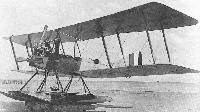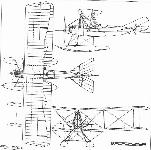
Описание
Страна: США
Год: 1916
Training seaplane
P.Bowers Boeing Aircraft since 1916 (Putnam)
MODEL 2 (C-4) - The C-4 was so named because it was the third aeroplane design used and the fourth aeroplane owned by Boeing, including the Martin seaplane. It was the second Boeing design, even though the firm was still known as Pacific Aero Products at the time it was built, and carried Serial Number 3 because it was the third aeroplane built. It was an entirely original design and differed considerably from the B & W both in basic aerodynamic characteristics and general appearance. The wings had an unusual degree of stagger and dihedral angle compared to other aircraft of the period for the purpose of providing inherent stability. This was considered by the Boeing engineers as the most desirable characteristic for a training aeroplane. The tail surfaces differed from the B & W in that the horizontal stabilizer was deleted and a vertical fin added. The C-4 was dismantled after testing but was rebuilt and flown in August 1918. See Model 3 for specifications.
MODEL 3 (C-5,6,11) - Slightly revised versions of the Model 2 (C-4), the major outward difference being rearrangement of the centre section struts to join at the centre line of the upper wing. C-5 and C-6 were sold to the US Navy for evaluation as trainers after the United States entered WW-I and C-11, rebuilt from the C-4, was delivered to a private owner in July 1918.
TECHNICAL DATA - C-5
Type: Trainer
Accommodation: 2 in tandem
Power plant: Hall-Scott A-7A, 100 hp
Span: 43 ft 10 in
Length: 27 ft overall
Height: 12 ft 7 in
Wing area: 495 sq ft
Empty weight: 1,898 lb
Gross weight: 2,395 lb
Max speed: 72.7 mph
Cruising speed: 65 mph
Service ceiling: 6,500 ft
Range: 200 miles
C/ns: 6,7,8
Navy serial numbers: 147, 148 (for 6 and 7)
MODEL 5 (C-650-700, C-1F, CL-4S) - Fifty Model 5s were ordered by the Navy as primary trainers following evaluation of the two Model 3s (C-5 and C-6) which can be considered the military prototypes. Since the production models were practically identical, Boeing retained the designation of Model C, supplementing it with the Navy-assigned serial number 650 to 699 for each individual aeroplane. The Navy ordered one additional aircraft (A-4347) for test with a single main float installation and a Curtiss OXX-6 engine. This was identified by Boeing as the C-1F (meaning Model C with one float). Before the C-1F was completed, the single float installation was tested on the rebuilt Model 2 (C-4), that became the C-11.
One additional Model C was built for William E Boeing, and since it followed the last Navy trainer, C-699, through the shop, it was logically called C-700. The C-700 was modified slightly in December 1918, and redesignated CL-4S, indicating a Model C with the new four-cylinder Hall-Scott L-4 engine. This aeroplane was used by William Boeing and Edward Hubbard on March 3, 1919, to make a demonstration international air mail flight from Vancouver to Seattle in connection with a Canadian exposition. This flight inspired the later inauguration of the Seattle - Victoria Contract International Air Mail route, where transpacific mail was delivered to and picked up from ships a day out of Seattle. Since it was operating in Canada at a time when Canadian aircraft had to carry registrations but US aircraft did not, it was registered as G-CADR (G for Great Britain, CA for Canada) for the initial part of its mail service. The G-prefix was soon changed to the assigned N for the United States to show its true ownership.
The Navy declared all the Model Cs surplus after WW-I, taking full-page ads in the aviation magazines to advertise them and quote the original price of $ 10,250 each. About the first thing the private owners did was to replace the highly unreliable Hall-Scott engines with either 90 hp Curtiss OX-5s or 150 hp Wright-Hispano surplus engines. Several Cs were still flying when US registration became mandatory in January 1927, and at least two were painted in German WW-I markings and crashed for the film 'Dawn Patrol' in 1931.
TECHNICAL DATA - C-650/C-700
Accommodation: 2 in tandem
Power plant: Hall-Scott A-7A, 100 hp
Span: 43 ft 10 in
Length: 27 ft overall
Height: 12 ft 7 in
Wing area: 495 sq ft
Empty weight: 1,898 lb
Gross weight: 2,395 lb
Max speed: 72.7 mph
Cruising speed: 65 mph
Service ceiling: 6,500 ft
Range: 200 miles
C/ns: 9/60
Navy serial numbers: 650/699 for c/n 10/59, 4347 for c/n 9
Описание:
- P.Bowers Boeing Aircraft since 1916 (Putnam)
- G.Swanborough, P.Bowers United States Navy Aircraft Since 1911 (Putnam)
- Jane's All The World Aircraft 1919
Фотографии
-
P.Bowers - Boeing Aircraft since 1916 /Putnam/
Boeing Model 2, the C-4 seaplane, with small vertical radiators and parallel centre section structs. The apparent dark colouring is varnish applied over clear-doped fabric.
-
G.Swanborough, P.Bowers - United States Navy Aircraft since 1911 /Putnam/
Boeing Model 3, the C-5 seaplane tested by the US Navy, before purchase of the Model Cs in quantity, with clear-doped finish and the new 1917 military tail striping. Compare larger radiators, modified centre section struts, and vertical tail size to Model 2.
-
P.Bowers - Boeing Aircraft since 1916 /Putnam/
One of the three Model 3 seaplanes fully assembled inside the original factory building, which also functioned as a hangar. In the background is Mr Boeing's original Martin seaplane in the process of coversion to a landplane.
-
P.Bowers - Boeing Aircraft since 1916 /Putnam/
The C-1F seaplane, a single-float version of the standard C-650-699 (Model 5) with Curtiss OXX-6 engine. Standard Navy colouring in 1918 was over-all stone grey.
-
P.Bowers - Boeing Aircraft since 1916 /Putnam/
The C-700, a private machine built for William Boeing's use at the end of Navy C-650-699 production and duplicating the Navy trainers even to the use of military markings. Note reversed order of rudder stripes from 1917.
-
P.Bowers - Boeing Aircraft since 1916 /Putnam/
The C-700 modified to CL-4S by installation of improved Hall-Scott L-4 engine and reduction of aileron size to straighten trailing edge of wing.
-
P.Bowers - Boeing Aircraft since 1916 /Putnam/
Assembly line of Model C fuselages. The cylindrical tanks in the rear held compressed air for the engine self-starters.
-
P.Bowers - Boeing Aircraft since 1916 /Putnam/
A war-surplus Boeing C converted to a landplane by a private owner. The unreliable 100 hp Hall-Scott A-7A engine was replaced by a dependable 150 hp Wright-Hispano. Note the two-seat front cockpit.
-
P.Bowers - Boeing Aircraft since 1916 /Putnam/
Uncovered forward fuselage of a Boeing Model C Navy trainer, showing the rear-cockpit instrumentation and the heavy laminated wood yoke of the 'Dep' control system.
-
P.Bowers - Boeing Aircraft since 1916 /Putnam/
BOEING MODEL 5 (C-700)











